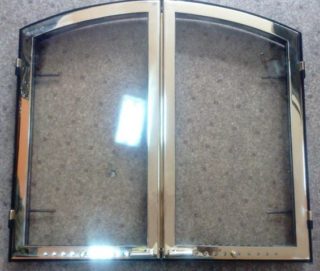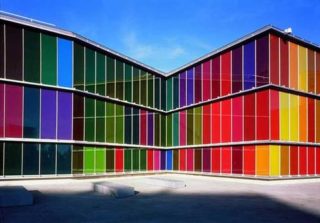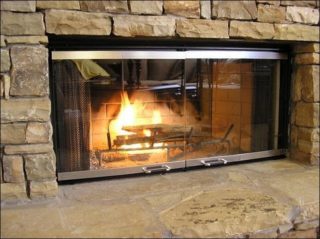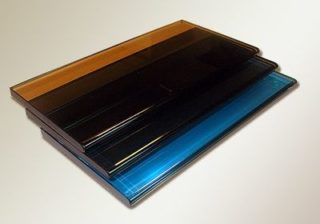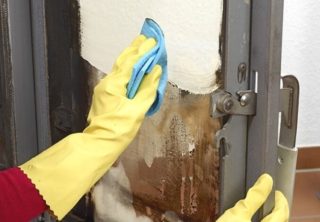The fireplace is a spectacular detail of the interior of the house and a convenient option for heating the room. The heating structure is divided into two types, taking into account the external structure of the furnace: open or closed. Fireplaces of the second type are supplemented with heat-resistant glass doors and are considered safer. Glass for the fireplace has its own nuances and characteristics, and is also presented in several versions. These nuances must be considered before buying and installing.
Properties and characteristics
The main criterion for choosing a mantelpiece is heat resistance, since the doors are subjected to severe loads from open fire. Fireproof glass designed for a fireplace must withstand extreme temperature changes. List of key features:
- heat resistance - the material must withstand loads at temperatures up to 500-550 degrees;
- strength - an optimal indicator of the thickness of at least 4-5 mm;
- Duration of operation - the best indicator up to 5000 hours;
- Appearance and design consistent with the style of the fireplace.
Thermal glass for the fireplace must undergo a polishing procedure during operation. It helps to make the material more durable and eliminate the likelihood of damage.
The advantages of glass doors
Glass for stoves and fireplaces have their advantages. First of all, it is an opportunity to observe the flame during the operation of the fireplace in combination with safety and a low level of fire hazard. A glass door allows you to regulate the process of burning fuel; during the operation of such a fireplace, a greater amount of thermal energy is released.
Fireplace doors perfectly cope with any loads, including exposure to high temperatures. If the glass breaks or breaks, you can immediately change it with your own hands without the need to call a specialist.
Varieties of glasses
Heat-resistant durable glass for a stove or fireplace can be one of the available types, the characteristics and features of which must be considered before choosing.
Heat resistant
Heat-resistant type safety glass is most often used as a protective screen for fireplaces. It is able to withstand large thermal loads, has an optimal sheet thickness and is characterized by increased strength. The coefficient of expansion of the temperature is almost zero, so the material will not burst or crack even with strong heating.
Laminated
Laminated glass doors for the stove consist of several glasses fastened together using a special liquid or film. Glass on such a fireplace panel will not crumble after an impact, fragments will remain fixed on the film. It is advisable to install it for those who are worried about the integrity of the fireplace door and want it to last as long as possible.
Color
Colored doors are installed as a decorative element, choosing them for the general style of the fireplace. Stained glass versions of glasses can solve various problems, including can hide ash and extinguishing fire inside the fireplace. Color thermal glass is also suitable for a modern type of stove.
Without soot
Special fire-resistant glass is not able to accumulate soot and soot, since it is treated from the inside with metal oxide. Due to this substance, the soot burns up without a trace and leaves no traces on the glass during the operation of the fireplace. This is the best choice for those who do not have time to clean the fireplace door.
Brand Selection
The most popular among manufacturers of fireplace glasses is the German brand Robax. This company has long been on the market, its products are known for their high level of quality. The working temperature of the material reaches 760 degrees. In addition to this brand, the list of famous brands includes:
- Nippon Electric Glass. The Japanese analogue of the German brand Robax with an increased working resource and a maximum temperature of 800 degrees.
- CrossFire Cerama. The Italian brand also has a high level of heat resistance, but its cost is lower compared to the Japanese and German counterparts.
- ABX. Glasses from the Czech brand have a heat resistance level of 600 degrees, are not prone to cracking.
It is worth choosing a manufacturer depending on the level of heat resistance. An important factor is the cost - with a limited budget, the best option would be the options from the Italian brand.
Fields of application
Heat-resistant glass is used to create doors for stoves and fireplaces, sometimes they are used to equip viewing panels that control draft in the heating system. It can also be used for roasting, barbecue and microwave. It is not recommended to use glass made to individual size in fireplaces, the temperature during which exceeds 750 degrees.
Often, borosilicate glass is used to make fireplace doors. It is resistant to aggressive environments and can withstand temperatures up to 450 degrees. It is also used to create screens for fixtures or heating devices, laboratory and industrial equipment. Often, a floor covering near the fireplace is made of such material for security reasons and to create additional interior details.
Features of installation and care
During the installation of the glass door, the coefficients for the expansion of the glass and frame material must be specified. The glass must not come into contact with the frame and fasteners in order to avoid overheating and prevent impacts when the door slams. It is necessary to ensure that the pressure at all attachment points is maintained at the same level without pinching. In case of deformation of the frames, joints with glasses are supplemented with heat-resistant cords.
Joints of glasses and frames cannot be sealed with heat-resistant sealant so that cracks do not form on the door.
Door care does not require much time and effort. Some modern models of fireplaces are supplemented with a system for burning all fuel completely, therefore they do not leave traces of soot and soot. If we are talking about a wood or gas fireplace, you will need additional care. The causes of soot formation can be different:
- the wrong amount of fuel relative to the air entering the burner of the gas fireplace;
- gas supply disruption in relation to air in propane-butane fireplaces or poor fuel quality;
- the use of coniferous firewood, forming a large amount of soot during burning.
To clean the glass screen, you can use special tools, such as spray or paste, which are sold in stores. The product is applied to the glass, wiped with a sponge and remove excess with a dry cloth. Doors can also be cleaned with ash, which is soaked and treated with sashes using newspapers, then washed off with water. Another home remedy is carbon liquid, made from vinegar and water in 1: 1 proportions.
For security reasons, fireplace doors are removed from the base and laid out on the floor. During cleaning, a solution is sprayed on them, after when the liquid dries, the glasses are wiped dry with newspapers. If the doors are hanging on fixed hinges, they are carefully treated with napkins soaked in solution.
